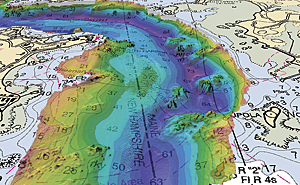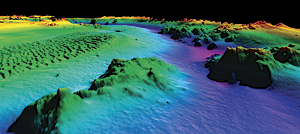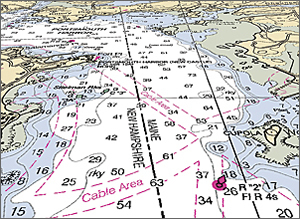Comprehensive Bathymetric Data Management Made More Efficient
Highlights
- The maritime industry now has tools and infrastructure to easily manage its information.
- Maritime GIS users maintain a historical archive for comparing legacy with modern data.
- For quality assurance, operators can identify areas of overlapping data to ensure accurate data collection.
Throughout history, understanding the ocean depths has been of significant interest. Being able to navigate the ocean waters has led to the rise and fall of empires; the discovery of new countries; and, recently, the use of their natural resources to sustain those who reside on land. The technology used today to chart the ocean floor is much more accurate than early techniques, which included throwing a premeasured heavy rope or cable over the side of a vessel or listening for the distant ping of a single-beam sonar device.

Using ArcGIS, operators can identify areas of overlapping data to check for quality assurance. (Credit: Shallow Survey Conference 2001/2008 and NOAA)
Today, multibeam sonar may be used, featuring hundreds of narrow, adjacent beams arranged in a fanlike swath, providing high angular resolution and accuracy. Capturing this massive amount of data requires technologies that expediently process the information and create the products necessary to understand it.
Esri and IVS 3D, an Esri Partner of Portsmouth, New Hampshire, are collaborating to create a workflow that hydrographers can rely on to capture this large amount of data. The companies have integrated their respective software, ArcGIS and Fledermaus, so hydrographic surveyors can bring bathymetric data directly into the GIS environment to not only map the ocean floor but also use the information for further analysis and visualization.
GIS for Hydrographers
Fledermaus is used internationally by government, commercial, and academic clients in all areas of ocean mapping. Scientists and engineers use the software for processing, quality control, and analysis of multibeam sonar and related data. The software provides significantly improved efficiency in nautical charting, geologic interpretation and assessment of seabed habitats, and identification of geohazards during engineering development work.
Now, using a seamless workflow, Fledermaus users can move bathymetric data from a traditional file-based desktop system directly into an ArcGIS geodatabase. They can then deploy the many capabilities of ArcGIS to analyze, author, and serve the data for charting and analysis.
Using a bathymetric geodatabase brings many advantages to maritime GIS users. They can maintain a historical archive for comparing legacy survey data with modern data and updated charts. They can also leverage bathymetric data by using it with other databases for a wide range of purposes, such as oceanography, coastal zone management, and meteorology, that require seafloor information. In addition, users can easily edit their nautical products based on new and updated bathymetric information.
Creating Solutions
Taking advantage of this integration is Geomatics Data Solutions, a small organization with offices in British Columbia, Canada, and San Diego, California. Focused on providing end-to-end geospatial processing applications for organizations needing bathymetric data, the company takes raw information and processes it to create final products such as nautical charts and geospatial databases.

Esri's bathymetric information system supports cloud computing mapping services via a maritime ArcGIS Server application, as well as desktop-based tools for updating navigational products. (Credit: Shallow Survey Conference 2001/2008)
Geomatics Data Solutions uses Fledermaus and the company's own add-on software solution, GreenC Solutions, for bathymetric lidar data editing. Then, the data QA/QC team uses both Fledermaus and ArcGIS to process and analyze the data.
As a majority of lidar products are created in ArcGIS formats, the combination of ArcGIS and Fledermaus aids processing. "This integration allows us to further streamline our process to get from raw data to final product more seamlessly and efficiently than we could before," says Carol Lockhart, cofounder and commercial manager, Geomatics Data Solutions.
Geomatics Data Solutions uses ArcGIS and Fledermaus together in two important ways:
Flight Line Editing
For areas of shoreline that are too shallow for traditional vessel-based technologies, airborne missions to collect flight lines are required. The acquired flight lines are stored in a geodatabase that also includes spatial areas defined as polygons to build custom Pure File Magic (PFM) files, the standard data structure developed at the US Naval Oceanographic Office, for data editing. The polygons are used to define the PFM extent, and the flight lines identify which files need to be read to import data to the PFM. Once created, the data can be viewed and edited in IVS 3D's software. Elevation surfaces and survey coverage extents created during editing are easily transferred to a geodatabase for further analysis, charting, and delivery to clients. For expedience, as well as quality assurance issues, it is important to be able to do this in an automated way when dealing with datasets that span a large spatial and temporal extent.

ArcGIS and Fledermaus bring bathymetric data into an environment for a wide variety of uses, including coastal charting. (Credit: NOAA)
Quality Assurance
Fledermaus and ArcGIS can be used for quality assurance and checking. All lidar projects are planned with some side overlap between adjacent flight lines to ensure accurate data collection. Using ArcGIS, operators can identify areas of overlapping data from adjacent lines then do a statistical comparison from one line's surface to another. Geomatics Data Solutions uses either Fledermaus Cross Check or ArcGIS to compute the statistical comparison, depending on whether a triangulated irregular network or grid is used.
Opening the Doors to a Marine Spatial Data Infrastructure
The large volume of many oceanographic and bathymetric datasets can make exporting and importing inefficient and prone to inaccuracies, but IVS 3D's partnership with Esri provides clients—many of whom are ArcGIS users—with a seamless connection to the power of an enterprise GIS.
"This has benefits for many additional geoprocessing features and off-the-shelf tools for publishing products and distribution," notes IVS 3D's general manager Lindsay Gee. "Many governments around the world have recognized the benefits of establishing a national spatial data infrastructure [SDI], and our integration with GIS allows clients in the marine environment to be directly part of a national digital geospatial framework without the need to build complicated connections between the marine and national SDIs."
Fledermaus software is valuable to bathymetric geodatabase design within the development of Esri's bathymetric information system. This system is composed of a data model that helps users organize bathymetric and survey data and communicate with other data models such as Esri Nautical Solution, Arc Marine, and petroleum and pipeline models. Esri's bathymetric information system will support cloud computing mapping services via a maritime ArcGIS Server application, as well as desktop-based tools for updating navigational products.
For more information on IVS 3D and how its visualization and analysis software is used in the nautical industry, contact Lindsay Gee, general manager (e-mail: info@ivs3d.com) or visit www.ivs3d.com. For more information on Geomatics Data Solutions, contact Carol Lockhart, owner, Geomatics Data Solutions (e-mail: info@GeomaticsDS.com) or visit www.GeomaticsDataSolutions.com. Find more information on Esri and how its GIS software is used in the hydrographic community by e-mailing bathymetry@esri.com or visiting esri.com/oceans.